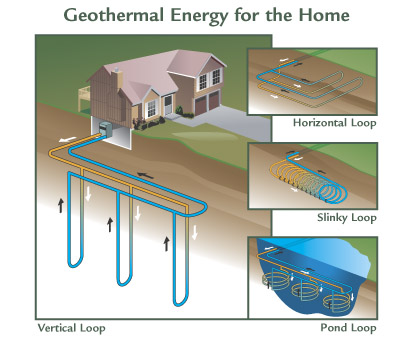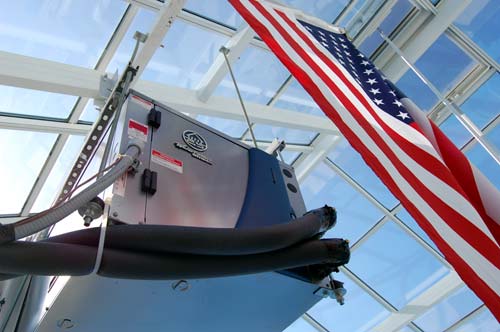The movement of homeowners to “go green” by utilizing geothermal heating and cooling is becoming ever more common. However, there is still a large part of the population who doesn’t even know where to begin when it comes to tackling the concept of geothermal. So let’s lay some groundwork, peel back the layers of this 21st-century question of “To go Geo or not to go Geo?” and see if geothermal in Louisville KY is right for your home.

How does a geothermal system work?
Outdoor temperatures fluctuate with the seasons. However, the underground temperatures remain more consistent. About four to six feet below the earth’s surface, the temperature remains relatively moderate and constant year-round.
In winter, fluid circulating through the geothermal system’s earth loop absorbs stored heat and carries it to the home. The indoor unit compresses the heat to a higher temperature and distributes it throughout the home. In summer, the geothermal system reverses, pulling heat from the home, and depositing it in the cooler earth. A geothermal system uses the energy from the sun, which is stored in the earth, to heat and cool homes.
Typically, electric power is used only to operate the unit’s fan, compressor, and pump. These systems simply transfer heat to and from the earth. If you are a tech guy or girl, check out the WaterFurnace website, which contains great information on how geothermal systems work, various loop systems for geothermal, and equipment specifications.
OK, Mr. Geothermal, what makes you so “green”?
Going green is a bigger and bigger topic in America today. Installing a single geothermal unit in your home or business is the environmental equivalent of planting 750 trees or removing two cars from the road. Geothermal heat pumps produce no emissions which means that they do not pollute the atmosphere. The U.S. General Accounting Office estimates that if geothermal systems were installed nationwide, Americans could save several billion dollars annually in energy costs and substantially reduce pollution.

By reducing the demand placed on electric utilities, geothermal systems reduce the need for new power plants. The systems minimize the threats of acid rain, air pollution, the greenhouse effect, and other environmental problems that are directly linked to burning fossil fuels. Since geothermal systems are recognized by the Environmental Protection Agency (EPA) as the most environmentally friendly heating and cooling technology available, it’s a system you can feel good about using.
Your own backyard has the potential to be your source of heating and cooling comfort. You can get safe, reliable, energy-efficient heating and cooling from one piece of equipment. Geothermal energy represents the leading edge of heating and cooling technology. It moves heat energy to and from the earth to heat and cool your indoor environment. Geothermal is the safest, cleanest, most reliable space conditioning system you can invest in.
Does my house qualify for geothermal?
Geothermal systems can be installed in new construction homes, as well as, existing homes. Existing home applications are typically referred to as “retrofit” designs. A home’s design does not dictate if geothermal can be installed, only access to the lot for drilling can put the brakes on a geothermal project.
Some would think that it would be impossible to drill through solid rock. However, it is actually one of the best heat transfer mediums for geothermal. In the Louisville, Kentucky area, you will usually see solid rock at about 15 feet. The ground may contain solid rock, clay, or sand. All of these ground materials can be drilled, provided you have access to bring in the drilling rig.
A smaller home will take a longer period of time before the initial investment is returned. However, there is not a 1:1 ratio for home size to pay off. The return time is dependent upon many variables some of which include insulation, the homeowner’s comfort settings, and the geothermal system installed.
What is the difference between a traditional system and geothermal?
Because geothermal systems use the energy found beneath the earth’s surface, they cost less to operate, with up to 60% cost savings, and generally last twice as long as conventional units. Also, unlike conventional systems, geothermal does not emit dangerous gases or fumes of any type.
Yeah, it sounds good but how much does it cost?
Geothermal typically costs about 2-3 times higher than a traditional high-end heating and cooling system. That means you’re looking at an investment of $14,000 and up. A large part of the system’s cost is related to the initial drilling so that the earth loops can be placed in the ground.
Like everything, a geothermal system does come with several upgrade options, one of which is the “de-super heater” option. This option allows the homeowner to divert excess heat produced during the heating and cooling process. The heat is then used to heat hot water for domestic hot water usage, resulting in “free hot water.”
The federal government is currently offering a 30% uncapped federal tax credit for installing a geothermal system. The 30% credit is based on the total installation cost of the system in your Louisville home. The current regulation states that you have until 2016 to take the federal tax credit. However, it is best to seek the advice of your tax professional for the specifics of your personal situation.
With geothermal being up to 500% efficient, you will get $5 for every $1 spent in energy. What this means is homeowners can see their initial investment returned in as little as 4 years, which opens the door for significant savings in the long term.
Example: Geothermal in Louisville KY
A typical home in Louisville measuring 3,000 sq. ft. could see an average monthly heating, cooling, and domestic hot water heating bill of $71.00 a month! For this situation, the estimated R.O.I. would be 5.7 years.
Not that there are many people living in a home this large, but a 10,000 sq. ft. Louisville home could see an average monthly heating, cooling, and domestic hot water heating bill of $157.00 a month! This R.O.I. is lowered to 4.8 years.



